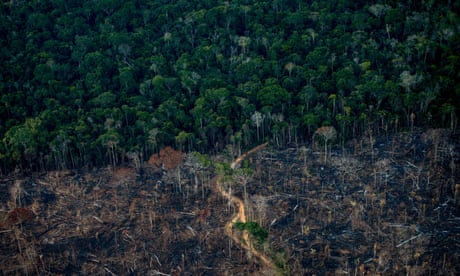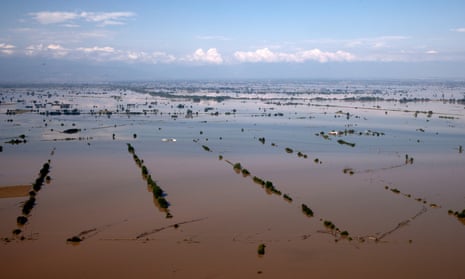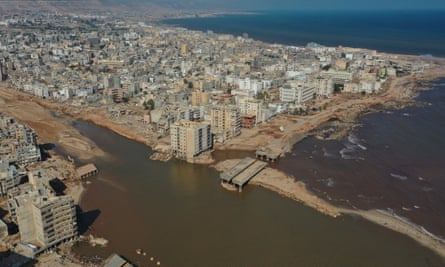The writer’s enjoyable obsession with the ‘other Naomi’ (Wolf), a conspiracy theorist, becomes a deeply insightful inquiry into the way technology fuels the polarisation of society

Down the rabbit hole: Naomi Klein. Photograph: Sebastian Nevols/The Guardian
Review
Tim Adams
THE GUARDIAN
Sun 17 Sep 2023
The first time it happened, Naomi Klein was in a public lavatory just off Wall Street in Manhattan. She heard two women discussing something she had said about the Occupy movement, which was then camped outside. Klein emerged from her cubicle to put the women right: it wasn’t her who had said those things, but she knew straight away who had. It must have been the “other Naomi” – Naomi Wolf. After that, the misunderstanding started happening more and more, particularly online.
It was true the pair of them had things in common, beyond the name. They had both written generation-defining bestselling polemics. In 1991, Wolf’s The Beauty Myth promoted the idea that eating disorders were by-products of the cosmetics and fashion industries; while Naomi Klein’s No Logo, nearly a decade later, had become a global rallying cry against the exploitative working practices of multinationals and their billionaire owners. They both (for the purposes of author photos at least) had big hair and broad smiles. They both were children of Jewish parents with alternative lifestyles. They both even had partners called Avi.
Her quest is not only the roots of Wolf’s journey to the ‘other side’ but for the blind spots in her own self-awareness
But while these similarities persisted, over the past 20 years the political journeys of the Naomis could hardly have been more distinct. Naomi Klein developed her original anti-corporate message into a critique of the environmental catastrophe of global capitalism that argues for a green New Deal. Naomi Wolf, meanwhile, made a strange journey from beauty myths to a full diet of conspiracy theory, pro-Trump activism and anti-vaccine extremism.
Even so, during the pandemic, the confusion became so pointed that one Twitter user even came up with a handy rhyme, to tell the two women apart:
If the Naomi be Klein
You’re doing just fine
If the Naomi be Wolf
Oh, buddy. Ooooof.
This book begins as an enjoyably obsessive investigation into that doppelganger relationship, touching on famous precedents: Charlie Chaplin’s The Great Dictator; Philip Roth’s Operation Shylock. It broadens into a deeply insightful inquiry into the ways in which the technology that drives our lives increasingly demands mirror-image doubles, tribal combatants to fuel a divided culture. This process, Klein argues, was accelerated by the restrictions and anxieties of the pandemic when “the [real] world was disappearing and so was I”.
In that enforced isolation, the activist-author found herself spending more and more time following her accidental nemesis down internet rabbit holes. Wolf, banned from Twitter for her crazy views, had by now become a star turn in the mirror world of “alt-right” YouTube and podcasts. Klein describes how she would occasionally emerge from this “doomscrolling” to inform her baffled husband of the latest outrage she had discovered: “She just wrote that ‘vaccinated people’s urine/faeces needs to be separated from general sewage supplies/waterways until its impact on unvaccinated people’s drinking water is established’.” By now Klein did not have to identify the “she” in question.
That proposition for an alternative water system might stand as a useful metaphor to describe the extremes of contemporary “us and them” that the story of Klein and Wolf comes to illustrate. Friends with a knowledge of her project keep asking Klein to explain exactly how Wolf came to “fall off a cliff” from liberal and scientific orthodoxy; but Klein is too good a writer to fall for that diagnosis. She is appalled and fascinated by her shadow principally because she wants to understand the motivations behind Wolf’s world view if not its unhinged conclusions. Wolf’s “Covid rollercoaster ride…” is, Klein comes to argue, if nothing else, a response to “what it increasingly feels like to be at the mercy of omnipresent technologies that are governed according to opaque algorithms… outside of existing laws”. The problem, she suggests, is that the explanation for that feeling is ascribed to “the wrong c”: conspiracy not capitalism.
Her quest in all of this is not only the roots of Wolf’s journey to the “other side” but for the blind spots in her own self-awareness. Like a rival general, Klein listens hard to Steve Bannon’s podcast War Room – on which Wolf has become a fixture with her own mass following (the “Wolf Pack”) – and identifies exactly the strategic political ground they seek to colonise; that new coalition between “the far right and the far out”. The unlikely crossover, for example, between the “wellness industry” and gun-loving libertarians, around the issue of vaccination. Campaigning with her husband, who is running as a New Democratic party candidate in Canada, she confronts insistent evidence of this on the doorstep – women with telltale “internet eyes”, one-time liberals who now spout received nonsense about global elites and casually suggest that the pandemic was sent to cull the weaker members of society.

Naomi Klein on following her ‘doppelganger’ down the conspiracy rabbit hole – and why millions of people have entered an alternative political reality
Klein’s instinct is not only to condemn. She makes the important case that the very nature of polarity now means that crucial journalistic questions go unanswered. There should, for example, have been legitimate scepticism about the UN acceptance of China’s story of the origins of the Covid virus, or about Bill Gates’s defence of the drug companies’ insistence on patents for their vaccines. But the mere fact that the conspiracists on Wolf’s side amplified those issues meant that such arguments were ignored or under-investigated. “Once an issue is touched by ‘them’ it seems to become oddly untouchable by almost everyone else,” Klein observes of what is a growing and dangerous trend.
Her book is a powerful antidote to such instincts. In articulating and examining some of the darker forces of the world her “double” inhabits, Klein never forgets that the primary purpose of mirrors is actually self-reflection; to understand the other, you first have to know yourself.
Doppelganger: A Trip Into the Mirror World by Naomi Klein is published by Allen Lane (£25).
Review
Tim Adams
THE GUARDIAN
Sun 17 Sep 2023
The first time it happened, Naomi Klein was in a public lavatory just off Wall Street in Manhattan. She heard two women discussing something she had said about the Occupy movement, which was then camped outside. Klein emerged from her cubicle to put the women right: it wasn’t her who had said those things, but she knew straight away who had. It must have been the “other Naomi” – Naomi Wolf. After that, the misunderstanding started happening more and more, particularly online.
It was true the pair of them had things in common, beyond the name. They had both written generation-defining bestselling polemics. In 1991, Wolf’s The Beauty Myth promoted the idea that eating disorders were by-products of the cosmetics and fashion industries; while Naomi Klein’s No Logo, nearly a decade later, had become a global rallying cry against the exploitative working practices of multinationals and their billionaire owners. They both (for the purposes of author photos at least) had big hair and broad smiles. They both were children of Jewish parents with alternative lifestyles. They both even had partners called Avi.
Her quest is not only the roots of Wolf’s journey to the ‘other side’ but for the blind spots in her own self-awareness
But while these similarities persisted, over the past 20 years the political journeys of the Naomis could hardly have been more distinct. Naomi Klein developed her original anti-corporate message into a critique of the environmental catastrophe of global capitalism that argues for a green New Deal. Naomi Wolf, meanwhile, made a strange journey from beauty myths to a full diet of conspiracy theory, pro-Trump activism and anti-vaccine extremism.
Even so, during the pandemic, the confusion became so pointed that one Twitter user even came up with a handy rhyme, to tell the two women apart:
If the Naomi be Klein
You’re doing just fine
If the Naomi be Wolf
Oh, buddy. Ooooof.
This book begins as an enjoyably obsessive investigation into that doppelganger relationship, touching on famous precedents: Charlie Chaplin’s The Great Dictator; Philip Roth’s Operation Shylock. It broadens into a deeply insightful inquiry into the ways in which the technology that drives our lives increasingly demands mirror-image doubles, tribal combatants to fuel a divided culture. This process, Klein argues, was accelerated by the restrictions and anxieties of the pandemic when “the [real] world was disappearing and so was I”.
In that enforced isolation, the activist-author found herself spending more and more time following her accidental nemesis down internet rabbit holes. Wolf, banned from Twitter for her crazy views, had by now become a star turn in the mirror world of “alt-right” YouTube and podcasts. Klein describes how she would occasionally emerge from this “doomscrolling” to inform her baffled husband of the latest outrage she had discovered: “She just wrote that ‘vaccinated people’s urine/faeces needs to be separated from general sewage supplies/waterways until its impact on unvaccinated people’s drinking water is established’.” By now Klein did not have to identify the “she” in question.
That proposition for an alternative water system might stand as a useful metaphor to describe the extremes of contemporary “us and them” that the story of Klein and Wolf comes to illustrate. Friends with a knowledge of her project keep asking Klein to explain exactly how Wolf came to “fall off a cliff” from liberal and scientific orthodoxy; but Klein is too good a writer to fall for that diagnosis. She is appalled and fascinated by her shadow principally because she wants to understand the motivations behind Wolf’s world view if not its unhinged conclusions. Wolf’s “Covid rollercoaster ride…” is, Klein comes to argue, if nothing else, a response to “what it increasingly feels like to be at the mercy of omnipresent technologies that are governed according to opaque algorithms… outside of existing laws”. The problem, she suggests, is that the explanation for that feeling is ascribed to “the wrong c”: conspiracy not capitalism.
Her quest in all of this is not only the roots of Wolf’s journey to the “other side” but for the blind spots in her own self-awareness. Like a rival general, Klein listens hard to Steve Bannon’s podcast War Room – on which Wolf has become a fixture with her own mass following (the “Wolf Pack”) – and identifies exactly the strategic political ground they seek to colonise; that new coalition between “the far right and the far out”. The unlikely crossover, for example, between the “wellness industry” and gun-loving libertarians, around the issue of vaccination. Campaigning with her husband, who is running as a New Democratic party candidate in Canada, she confronts insistent evidence of this on the doorstep – women with telltale “internet eyes”, one-time liberals who now spout received nonsense about global elites and casually suggest that the pandemic was sent to cull the weaker members of society.

Naomi Klein on following her ‘doppelganger’ down the conspiracy rabbit hole – and why millions of people have entered an alternative political reality
Klein’s instinct is not only to condemn. She makes the important case that the very nature of polarity now means that crucial journalistic questions go unanswered. There should, for example, have been legitimate scepticism about the UN acceptance of China’s story of the origins of the Covid virus, or about Bill Gates’s defence of the drug companies’ insistence on patents for their vaccines. But the mere fact that the conspiracists on Wolf’s side amplified those issues meant that such arguments were ignored or under-investigated. “Once an issue is touched by ‘them’ it seems to become oddly untouchable by almost everyone else,” Klein observes of what is a growing and dangerous trend.
Her book is a powerful antidote to such instincts. In articulating and examining some of the darker forces of the world her “double” inhabits, Klein never forgets that the primary purpose of mirrors is actually self-reflection; to understand the other, you first have to know yourself.
Doppelganger: A Trip Into the Mirror World by Naomi Klein is published by Allen Lane (£25).










 An aerial view of the devastation of Derna, Libya, 17 September 2023. Photograph: Halil Fidan/Anadolu Agency/Getty Images
An aerial view of the devastation of Derna, Libya, 17 September 2023. Photograph: Halil Fidan/Anadolu Agency/Getty Images


